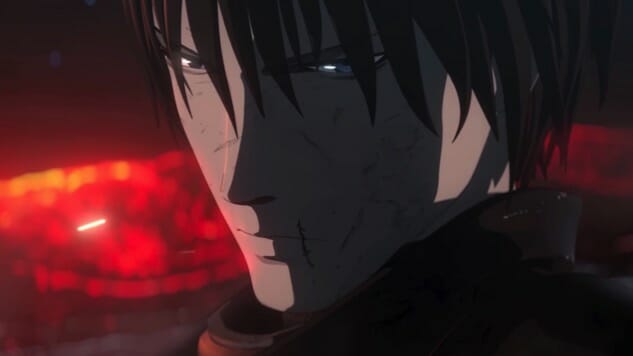When it comes to dark industrial sci-fi, Tsutomu Nihei is a visionary. Trained as an architect before pursuing a career as a manga author, Nihei’s art is simultaneously sparse and labyrinthine, his body of work defined by a unifying obsession with invented spaces. Byzantine factories with gothic accents spanning across impossible chasms, populated by bow-legged synthoids and ghoulish predators touting serrated bone-swords and pulsating gristle-guns. His first and most famous series, Blame!, is considered the key text in Nihei’s aesthetic legacy, going so far as to inspire everything from video games, to music, and even art and fashion. Past attempts have been made to adapt the series into an anime, though none have been able to materialize successfully. That is, until now. With the support of Netflix, Hiroyuki Seshita of Polygon Pictures has delivered that long-awaited Blame! film. But can it succeed where others have so often failed?
Set on a far-future Earth consumed by a massive, self-replicating superstructure known as ‘The City’, Blame! follows Killy, a taciturn loner, wandering the layers of the planet in search of a human possessing the ‘net terminal gene,’ an elusive trait thought to be the only means of halting the city’s perpetual hostile expansion. Through his search Killy encounters Zuru, a young woman from a small village of humans eking out a meager existence despite the constant barrage of the city’s automated security forces. He elects to help them and, in doing so, meets a mysterious scientist who claims to have found a means of accessing the city’s system without the need for the terminal gene.
Having had experience with Nihei’s work through his directorial stint on Knights of Sidonia (in which Blame! itself makes a notable cameo) and his complimentary work on the television anime of Gamon Sakurai’s Ajin: Demi-Human, Seshita is perhaps the best of all possible directors to spearhead a Blame! adaptation. Boasting a screenplay penned by Sadayuki Murai, famed for his writing on such series as Cowboy Bebop and Satoshi Kon’s Perfect Blue, and supervised by Nihei himself, the film abbreviates much of the manga’s early chapters and streamlines the story into an altogether more narrative and action-driven affair. Art director Hiroshi Takiguchi deftly replicates Nihei’s distinctive aesthetic, achieving in color what was before only monochromatic, while Yuki Moriyama capably improves on the uniform character designs of the original, imparting its casts with distinct, easily identifiable traits and silhouettes that greatly improve the story’s parsability.
The chief concern behind any adaptation of Blame! is that it exhibits an understanding of what the manga’s core appeal is, and pays proper service to it. Despite its name in Japanese being a onomatopoeia for the phonetic sound of a gunshot, Blame! is not a series defined solely through violence. While yes, images of death and dismemberment are no stranger across its pages, they ultimately function as punctuation interspersed between prolonged sentences. The real meat of the series lies in Nihei’s aforementioned backgrounds, their massive brutalist dimensions all but dwarfing its inhabitants in scale, to the point where they arguably function as principal characters themselves. To lose this would mean to lose the heart of what has made Blame! not only a popular manga, but an enduring aesthetic milestone. Luckily, the film understands and embraces this quality in full, with languid expository pan overs across whole swaths of sprawling industrial desolation whose breadth and detail are worthy of comparison alongside that of the Wachowski’s iconic “deserts of the real” from The Matrix.
Composer Yugo Kanno, known for his work on Psycho-Pass and Jojo’s Bizarre Adventure, delivers a fantastic score that buoys the film’s most memorable moments. Subdued sound editing and voluminous echoes give rise to the tensest of silences, while the somber piano motif that denotes Killy’s introduction segues perfectly into a thunderous onslaught of bass-heavy synths. The film’s animation, particularly in its fight scenes, is especially worthy of note, though the frame-rate noticeably dips during the film’s busiest of sequences. Still, the film is a visual gem, each set piece rendered with an impeccable level of polish and attention that does justice to Nihei’s penchant skill for depicting monolithic dimensions.
Blame! is as faithful an adaptation as is possible and as fitting an introduction to the series as the manga itself. It’s true that, in the migration to the big screen, the film by its nature loses some of the characteristic melancholy and slow journeyman pacing which defined the series’ initial chapters, though this is by design. Nihei and Seshita set out to craft a movie that would retain the original’s appeal, while opening it up to a wider audience, and by all accounts they have succeeded. Blame! builds a strong case for being not only one of the most conceptually entertaining anime films of late, but also for being one of, if not the best original anime film to grace Netflix in a long time.
Director: Hiroyuki Seshita
Writer: Sadayuki Murai, Tsutomu Nihei
Starring: Sora Amamiya, Kana Hanazawa, Takahiro Sakurai
Release Date: May 20, 2017
